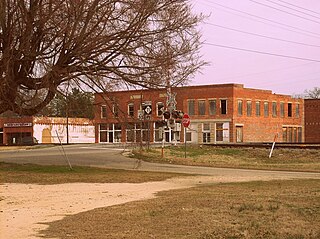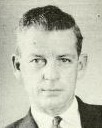Related Research Articles

Robeson County is a county in the southern part of the U.S. state of North Carolina and is its largest county by land area. Its county seat is and largest city is Lumberton. The county was formed in 1787 from part of Bladen County and named in honor of Thomas Robeson, a colonel who had led Patriot forces in the area during the Revolutionary War. As of the 2020 census, the county's population was 116,530. It is a majority-minority county; its residents are approximately 38 percent Native American, 22 percent white, 22 percent black, and 10 percent Hispanic. It is included in the Fayetteville–Lumberton–Laurinburg, NC Combined Statistical Area. The state-recognized Lumbee Tribe of North Carolina is headquartered in Pembroke.

Lumberton is a city in Robeson County, North Carolina, United States. As of 2020, its population was 19,025. It is the seat of Robeson County's government.

Parkton is a town in Robeson County, North Carolina, Lumberton metro area, United States. The town was so named because it was a place where farmers tied up their horses while waiting for the train. As of the 2010 census, the town population was 436.

St. Pauls is a town in Robeson County, North Carolina, United States. The population was 2,035 at the 2010 census.

Douglas Carmichael "Mike" McIntyre II is an American attorney and politician who was first elected to represent North Carolina's 7th congressional district in the U.S. House of Representatives in 1996. He served for 18 years from 1997 to 2015. McIntyre is a Democrat and, during his tenure in the House of Representatives, was a member of the Blue Dog Coalition.
James William "Catfish" Cole was an American soldier and evangelist who was leader of the Ku Klux Klan of North Carolina and South Carolina, serving as a Grand Dragon.

Julian Thomas Pierce was an American lawyer and Lumbee activist. Born in Hoke County, North Carolina, he became the first person in his family to go to college and worked for several years as a chemist at shipyards in Virginia before obtaining his law degree. Following two years of work for the U.S. Securities and Exchange Commission, he moved to Robeson County, North Carolina to direct a legal aid organization and in that capacity co-authored a petition to the federal government asking for the extension of federal recognition to the Lumbee tribe. In 1988 he resigned from his job to pursue a candidacy for a new Superior Court judgeship. Running against the local district attorney and over the objections of the county sheriff, he was found murdered in his home several weeks before the primary election. While his murder was officially determined to be the result of an interpersonal dispute, the circumstances of his death remain unclear, with his friends and family having advanced suspicions that he was assassinated for political reasons.
Middle Creek High School is located 123 Middle Creek Park Avenue of Cary, North Carolina, with a mailing address of Apex. It is one of six public high schools in Cary and is part of the Wake County Public School System.
Sumter High School is a co-educational four-year public high school serving grades 9 through 12 in Sumter School District located in the south side of Sumter, South Carolina, United States. With an enrollment of approximately 2,400 students, Sumter High is the second-largest high school in the Midlands of South Carolina and the fifth largest in the state of South Carolina. In 2004 Sumter High School was designated The Model School for SC and one of thirty model schools nationwide by a national organization funded by the Bill and Melinda Gates Foundation.
Gaston Layton Pridgen, known as G. L. Pridgen, is a former Republican member of the North Carolina House of Representatives. In the House of Representatives, he represented the 46th District, including constituents in Hoke, Robeson, and Scotland counties from 2011 to 2013. A retired telecommunications technician from Lumberton, North Carolina Pridgen also has experience in the United States Military.
Public Schools of Robeson County is a school district headquartered in Lumberton, North Carolina. It operates public schools in Robeson County.
Champaign Community Unit School District No. 4 is a unit school district with over 10,000 students and 19 campuses covering Champaign and the villages of Bondville and Savoy in Champaign County, Illinois, United States. It was formed in 1948 from thirteen school districts.
Lumberton Senior High School is a high school located in Lumberton, North Carolina, serving grades 9–12. It is run by the Public Schools of Robeson County, as it is in Robeson County, North Carolina.

Malcolm Buie Seawell was an American lawyer and politician. A member of the Democratic Party, he served as North Carolina Attorney General from 1958 to 1960. Seawell was raised in Lee County, North Carolina. After law school, he moved to Lumberton and joined a law firm. From 1942 to 1945 he worked for the U.S. Department of War in Washington, D.C. He then returned to Lumberton and successfully ran for the office of mayor in 1947. He held the post until the following year when he was appointed 9th Solicitorial District Solicitor. While working as solicitor Seawell gained state-wide prominence for his aggressive efforts to prosecute the Ku Klux Klan (KKK), and was credited for ultimately pushing the organization out of Robeson County. Governor Luther H. Hodges later made him a judge before appointing him Attorney General of North Carolina in 1958 to fill a vacancy.
Ruth Dial Woods is an American educator and activist. A member of the Lumbee Tribe of North Carolina, she was the first woman to serve as the associate superintendent of the Robeson County Public Schools and to receive an at-large appointment to the University of North Carolina Board of Governors. After teaching in the public school system of Robeson County for 27 years, she joined the faculty at Fayetteville State University. In addition to her work as an educator, Woods was involved in the Civil Rights Movement, the Women's liberation movement, and the American Indian Movement. She has served as a community development consultant for the United States Department of Labor and as a consultant for the Lumbee Tribal Council for administration of tribal programs. The recipient of numerous awards and honors for her work in human rights and education, in 2011, she was inducted into the North Carolina Women's Hall of Fame.

Horace Locklear is an American politician and former attorney who served in the North Carolina House of Representatives from 1977 until 1983. A member of the Lumbee tribe, he was the first Native American to practice law in North Carolina.
Malcolm Gray McLeod was an American law enforcement officer who served as the Sheriff of Robeson County, North Carolina from 1950 to 1978. Born in Lumberton, he worked as a service station operator and a grocery salesman before deciding to run for the office of sheriff in 1950, pledging to modernize the office and crack down on bootlegging. He won, and in his early tenure worked closely with District Solicitor Malcolm Buie Seawell to destroy thousands of illicit alcohol distilleries and oversee hundreds of arrests for bootlegging. In 1958 he maintained order during a civil disturbance at the Battle of Hayes Pond. Over the course of his tenure the size of the sheriff's department expanded and he hired several black and Native American deputies. In 1971 McLeod established a drugs division in the department to combat the narcotics trade. At the time of his retirement in 1978 he was the longest-serving sheriff in Robeson County's history.
Walter Hubert Stone was an American law enforcement officer who served as the Sheriff of Robeson County, North Carolina from 1978 to December 1994. Stone was raised in Robeson County, and in 1953 became a municipal police officer. He served as police chief of Fair Bluff from 1954 to 1957, when he was hired as a county sheriff's deputy. He was promoted to the job of detective before being elected Sheriff of Robeson County in 1978. He restructured the organization of the sheriff's department, assigning sergeants and detectives to districts in the county. During his tenure the county experience a significant level of drug trafficking, and he oversaw the doubling in size of his office's drug enforcement division and worked closely with District Attorney Joe Freeman Britt to prosecute narcotics-related offenses. A Democrat, he became a leading figure in local politics and was often sought by candidates for his support.
On February 1, 1988, two armed Tuscarora men, Eddie Hatcher and Timothy Jacobs, took hostages in the offices of The Robesonian newspaper in Lumberton, Robeson County, North Carolina. At the time, Robeson experienced a significant level of drug trafficking and increasing public distrust of the county sheriff's office, especially from the area's significant Native American population. Hatcher believed he had evidence of corruption in the local justice system and, fearing for his life, enlisted the aid of Jacobs to try to raise awareness about his concerns. The two held the staff of the county daily newspaper hostage for 10 hours before extracting an agreement from North Carolina Governor James G. Martin to investigate corruption allegations in Robeson.

Richard Montgomery Norment was an American physician, politician, and military officer.
References
- 1 2 K. Blake Tyner, Robeson County in Vintage Postcards, Postcard history series, Charleston, South Carolina: Arcadia, ISBN 9780738541624, p. 82.
- 1 2 History, Littlefield Middle School, Public Schools of Robeson County, retrieved September 5, 2020.
- ↑ Rodd Baxley, "Littlefield High School’s 1965 state title team celebrates 50th anniversary", The Robesonian, November 19, 2015.
- ↑ "Collins, longtime coach, dies", The Robesonian, July 28, 2015.